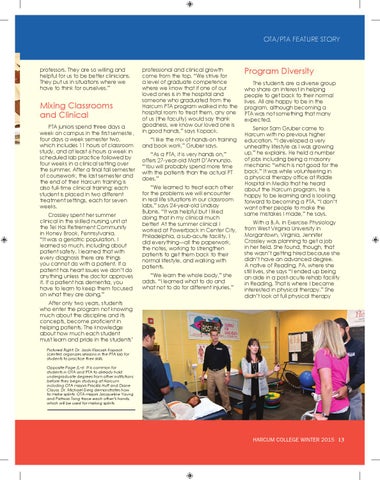OTA/PTA FEATURE STORY
professors. They are so willing and helpful for us to be better clinicians. They put us in situations where we have to think for ourselves.”
Mixing Classrooms and Clinical PTA juniors spend three days a week on campus in the first semeste , four days a week semester two, which includes 11 hours of classroom study, and at least 6 hours a week in scheduled lab practice followed by four weeks in a clinical setting over the summer. After a final fall semester of coursework, the last semester and the end of their Harcum training is also full-time clinical training; each student is placed in two different treatment settings, each for seven weeks. Crossley spent her summer clinical in the skilled nursing unit at the Tel Hai Retirement Community in Honey Brook, Pennsylvania. “It was a geriatric population. I learned so much, including about patient safety. I learned that with every diagnosis there are things you cannot do with a patient. If a patient has heart issues we don’t do anything unless the doctor approves it. If a patient has dementia, you have to learn to keep them focused on what they are doing.”
professional and clinical growth come from the top. “We strive for a level of graduate competence where we know that if one of our loved ones is in the hospital and someone who graduated from the Harcum PTA program walked into the hospital room to treat them, any one of us (the faculty) would say thank goodness, we know our loved one is in good hands,” says Kopack. “I like the mix of hands-on training and book work,” Gruber says. “As a PTA, it is very hands on,” offers 27-year-old Matt D’Annunzio. “You will probably spend more time with the patients than the actual PT does.” “We learned to treat each other for the problems we will encounter in real life situations in our classroom labs,” says 24-year-old Lindsay Bubnis. “It was helpful but I liked doing that in my clinical much better! At the summer clinical I worked at Powerback in Center City, Philadelphia, a sub-acute facility. I did everything—all the paperwork, the notes, working to strengthen patients to get them back to their normal lifestyle, and walking with patients. “We learn the whole body,” she adds. “I learned what to do and what not to do for different injuries.”
Program Diversity The students are a diverse group who share an interest in helping people to get back to their normal lives. All are happy to be in the program, although becoming a PTA was not something that many expected. Senior Sam Gruber came to Harcum with no previous higher education. “I developed a very unhealthy lifestyle as I was growing up,” he explains. He held a number of jobs including being a masonry mechanic “which is not good for the back.” It was while volunteering in a physical therapy office at Riddle Hospital in Media that he heard about the Harcum program. He is happy to be learning and is looking forward to becoming a PTA. “I don’t want other people to make the same mistakes I made,” he says. With a B.A. in Exercise Physiology from West Virginia University in Morgantown, Virginia, Jennifer Crossley was planning to get a job in her field. She found, though, that she wasn’t getting hired because she didn’t have an advanced degree. A native of Reading, PA, where she still lives, she says “I ended up being an aide in a post-acute rehab facility in Reading. That is where I became interested in physical therapy.” She didn’t look at full physical therapy
After only two years, students who enter the program not knowing much about the discipline and its concepts, become proficient in helping patients. The knowledge about how much each student must learn and pride in the students’ Pictured Right: Dr. Jacki Klaczak Kopack (center) organizes sessions in the PTA lab for students to practice their skills. Opposite Page (L–r): It is common for students in OTA and PTA to already hold undergraduate degrees from other institutions before they begin studying at Harcum including OTA majors Priscilla Huff and Diane Clauss. Dr. Michael Gerg demonstrates how to make splints. OTA majors Jacqueline Young and Patricia Tong trace each other’s hands, which will be used for making splints.
HARCUM COLLEGE WINTER 2015 13
